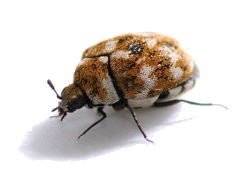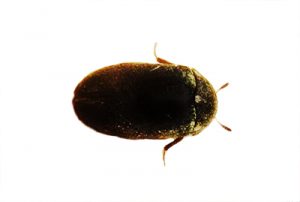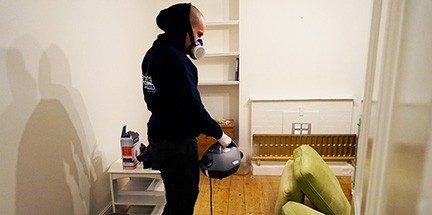Carpet Beetles
Carpet beetles are flying insects, part of the family Dermestids (leather beetles). They are a common pest in warehouses, museums, homes and poultry houses. While adults of those beetles feed on flower pollen, carpet beetle damage by larvae to leather, textile and fur items can be irreparable.
Types of Carpet Beetles
Varied Carpet Beetles (Anthrenus verbasci)

Varied carpet beetles are black beetles, 3mm long with irregular patterns of white. They have brownish-black transparent wings. Their larvae are hairy, brown in colour and reach 5mm in length. Because of their appearance, the larvae are known as “woolly bears”. Varied carpet beetles are the most widespread species of Dermestids and can be found on every continent except Australia and Antarctica.
Image by: Jean-Raphaël Guillaumin
Fur Beetle (Attagenus pellio)

Fur beetles are 4-6mm long beetles with oval bodies. They are dark-brown to black in colour and have a white spot on each wing case. Without knowledge of their appearance, they can be easily mistaken for oriental cockroaches. The larva reaches 6mm in length and has orange tufts of hair. It feeds on fur (hence its name) and is common in bird nests.
Image by: David Short
Leather Beetles (Dermestes maculatus)

The adults of the Leather beetle have black-grey bodies with white bellies. They reach 6-10mm in length. Their larvae are hairy, black, with a yellow “spine” on their backs. Leather beetle larvae can reach up to 12mm and can be mistaken for a moth or butterfly caterpillar. They feed on leather and can be found in poultry houses.
Image by: Udo Schmidt
Check also:
Most common types of carpet beetles in the UK
Carpet Beetle Damage
Carpet beetle larvae cause damage to animal materials found in homes, offices and museums. Carpet beetle damage includes holes and trail-like patterns in fabrics of:
- Carpets and rugs made out of natural materials such as wool
- Leather sofas
- Animal materials such as fur, feathers and even dried fish
- Leather bookbindings
- Photos and paintings
Carpet beetle larvae feed on dry protein so they are likely to attack any of the above items. Some of them can get quite expensive and the irreversible damage might be infuriating. Unfortunately, legal rental arrangements in the UK don’t cover carpet beetle insurance. The best way to deal with the problem is to stay ahead of it!
Diet & Habits
Carpet beetles borrow their name from the fact their larvae feed on the carpet. The adults however feed on pollen and pollinate different flowers. They are attracted to light and actively seek it during the night. Carpet beetles borrow through lead and hide in spider webs—two uncommon traits for the insect kingdom. They can even make homes in old bee and wasp nests, provided the nests are empty.
Carpet beetles reproduce once or twice per year. They lay up to 150 eggs—it takes two weeks for the carpet beetle eggs to hatch. Depending on the climate, it takes larvae up to two years to develop as adults. This means that if they remain unnoticed, carpet beetles have over a year to cause destructive damage to textile and leather items.
How to Control and Manage Carpet Beetles?
 Unlike other insect pests, it is hard to prevent the occurrence of a Carpet beetle infestation. As they feed on textiles and leather, there’s also an abundance of food sources in your house. The only thing which can avert an infestation is a high level of hygiene and frequent steam-clean of the carpets and upholstery. This is also the method used for handling small-scale carpet beetle infestations.
Unlike other insect pests, it is hard to prevent the occurrence of a Carpet beetle infestation. As they feed on textiles and leather, there’s also an abundance of food sources in your house. The only thing which can avert an infestation is a high level of hygiene and frequent steam-clean of the carpets and upholstery. This is also the method used for handling small-scale carpet beetle infestations.
Some products are labelled as "protective sprays against Carpet beetles". It is important not to use such products on leather items. They can also damage carpets. An alternative to those products is moth crystals, as they repel carpet beetles as well.
Heavy infestations must be dealt with with the help of insecticides. Limit spraying to the edges of your carpets, cracks, vents, crevices and other openings where Carpet beetles may hide. If their larvae burrow inside upholstered items (such as furniture, mattresses and pillows) professional carpet beetle treatment is needed.
As carpet beetles damage textiles and leather, sometimes the cause of infestation can be as simple as a dead rodent between the walls of the building.
- Mummified corpses of rats and mice attract Fur beetles and Leather beetles.
- Dry pet food—both dog and cat—can also attract carpet beetles. It is important to check such food sources on a regular basis to prevent widespread infestation.
- Lint, hair, and other detritus in great amounts provide both food and shelter and serve as the perfect breeding ground for Dermestids.
Both adult and larvae carpet beetles can be seen crawling on various surfaces, especially leather and upholstery. Adult beetles fly and are attracted by light sources. The most likely evidence of an infestation is carpet beetle damage left behind by larvae. Irregular holes in leather and carpets indicate textile-eating insects infestation—either moth or carpet beetle. In both cases, immediate actions must be taken to prevent further damage.
As they grow, carpet beetle larvae shed skin, however, the casings do not have any remarkable characteristics and only a professional can tell it apart from skin sheds of other insects. Adults also produce black, grain-sized excrements close to their food sources.
Get your home inspected by a certified pest technician!
Book inspection nowKeep in mind that we only aim to provide some useful information about carpet beetles in general. We cannot guarantee that the insects you're dealing with correspond to the same description.


